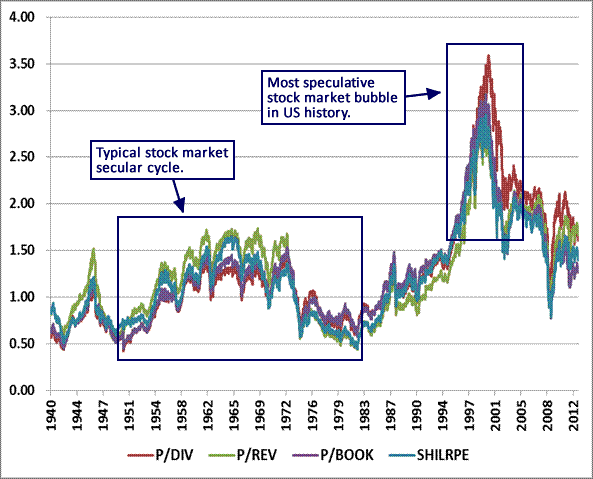Very few mainstream analysts spend sufficient time analyzing the secular environment of the stock market. In order to develop reliable investment forecasts, it is first necessary to understand the state and character of the current secular cycle.
Analysts often formulate projections based upon market behavior during the last 20 years, assuming that data since 1990 reflects a “normal” market. Unfortunately, the 1990s saw the inflation of the most speculative stock market bubble in US history, creating massive distortions from which we are still recovering. To call the last 20 years “normal” in any sense misses the big picture completely, as fund manager John Hussman discussed in his latest weekly commentary.
In the day-to-day focus on the “fiscal cliff,” our own concern about a U.S. recession already in progress, and the inevitable flare-up of European banking and sovereign debt strains, it’s easy to overlook the primary reason that we are defensive here: stocks are overvalued, and market conditions have moved in a two-step sequence from overvalued, overbought, overbullish, rising yield conditions (and an army of other hostile indicator syndromes) to a breakdown in market internals and trend-following measures.
Once in place, that sequence has generally produced very negative outcomes, on average. In that context, even impressive surges in advances versus declines (as we saw last week) have not mitigated those outcomes, on average, unless they occur after stocks have declined precipitously from their highs. Our estimates of prospective stock market return/risk, on a blended horizon from 2-weeks to 18-months, remains among the most negative that we’ve observed in a century of market data.
On the valuation front, Wall Street has been lulled into complacency by record profit margins born of extreme fiscal deficits and depressed savings rates. Profits as a share of GDP are presently about 70% of their historical norm, and profit margins have historically been highly sensitive to cyclical fluctuations. So the seemingly benign ratio of “price to forward operating earnings” is benign only because those forward operating earnings are far out of line with what could reasonably expected on a sustained long-term basis.
It’s helpful to examine valuations that are based on “fundamentals” that don’t fluctuate strongly in response to temporary ups and downs of the business cycle. The chart below compares historical price/dividend, price/revenue, price/book and Shiller P/E (S&P 500 divided by the 10-year average of inflation-adjusted earnings) to their respective historical norms prior to the late-1990’s market bubble – a reading of 1.0 means that valuations are at their pre-bubble norm.
Note that outside of the bubble-era, major bull market peaks tended to occur with valuations about 30-50% above the historical norm, while bear markets regularly brought valuations back to the historical norm and often well below that level. “Secular” lows generally occurred at valuations about half the historical norm. The 2000 market peak (which the S&P 500 remains below, more than 12 years later) reached valuation multiples more than three times the historical norm.
Presently, on the basis of smooth fundamentals such as revenues, book values, dividends and cyclically-adjusted earnings, the S&P 500 is somewhere between 40-70% above pre-bubble valuation norms, depending on the measure. That’s about the same point they reached at the beginning of the 1965-1982 secular bear period, as well as the 1987 peak.
Stocks are far less overvalued than they were in the late-1990’s, but it is worth noting that nearly 14 years of poor market returns have resulted simply from the retreat from those bubble valuations to the current rich valuations. If presently rich valuations were to retreat again to undervalued levels that have accompanied the start of secular bull markets (see 1982 for example), stocks would produce yet another extended period of dismal returns. That prospect certainly isn’t the reason for our present defensiveness, but it’s worth understanding the dynamic that has produced the pattern of market returns we’ve observed over time.
The defining feature of dividends, revenues, book values and the 10-year average of inflation-adjusted earnings (the denominator of the Shiller P/E) is that they are smooth and insensitive to cyclical fluctuations in profit margins over the business cycle. In contrast, standard price/earnings ratios generally seem very reasonable when profit margins are elevated, and seem extreme when profit margins are depressed. Needless to say, that is no small risk for investors who are enamored with seemingly “reasonable” P/E ratios based on forward operating earnings (which assume that companies will indefinitely earn profit margins about 70% above historical norms).
The magnitude of the speculative imbalance introduced during the final phase of the previous secular bull market can also be seen on the long-term graph of our Secular Trend Score (STS).
In December 1999, the STS entered sell territory for the first time since the early 1970s, signaling the imminent termination of the bull market from the early 1980s. The STS subsequently remained in sell territory for approximately four years, reflecting the historic level of stock market overvaluation.
Additionally, during the 12 years since the secular bull market ended, the STS has failed to return to positive territory, indicating that the current secular bear is still several years away from its terminal phase. At some point, probably 5 to 10 years from now, the next great buying opportunity will occur in the stock market from an investment perspective.
At the moment, it is impossible to project with any useful amount of statistical certainty exactly when that opportunity will occur. Fortunately, secular inflection points develop slowly, usually over the course of 6 to 12 months, so the STS will provide plenty of advance warning when the next secular bull market is preparing to commence.
- English (UK)
- English (India)
- English (Canada)
- English (Australia)
- English (South Africa)
- English (Philippines)
- English (Nigeria)
- Deutsch
- Español (España)
- Español (México)
- Français
- Italiano
- Nederlands
- Português (Portugal)
- Polski
- Português (Brasil)
- Русский
- Türkçe
- العربية
- Ελληνικά
- Svenska
- Suomi
- עברית
- 日本語
- 한국어
- 简体中文
- 繁體中文
- Bahasa Indonesia
- Bahasa Melayu
- ไทย
- Tiếng Việt
- हिंदी
The Big Picture: Stock Market Valuation
Published 11/28/2012, 12:18 AM
Updated 07/09/2023, 06:31 AM
The Big Picture: Stock Market Valuation
3rd party Ad. Not an offer or recommendation by Investing.com. See disclosure here or
remove ads
.
Latest comments
Install Our App
Risk Disclosure: Trading in financial instruments and/or cryptocurrencies involves high risks including the risk of losing some, or all, of your investment amount, and may not be suitable for all investors. Prices of cryptocurrencies are extremely volatile and may be affected by external factors such as financial, regulatory or political events. Trading on margin increases the financial risks.
Before deciding to trade in financial instrument or cryptocurrencies you should be fully informed of the risks and costs associated with trading the financial markets, carefully consider your investment objectives, level of experience, and risk appetite, and seek professional advice where needed.
Fusion Media would like to remind you that the data contained in this website is not necessarily real-time nor accurate. The data and prices on the website are not necessarily provided by any market or exchange, but may be provided by market makers, and so prices may not be accurate and may differ from the actual price at any given market, meaning prices are indicative and not appropriate for trading purposes. Fusion Media and any provider of the data contained in this website will not accept liability for any loss or damage as a result of your trading, or your reliance on the information contained within this website.
It is prohibited to use, store, reproduce, display, modify, transmit or distribute the data contained in this website without the explicit prior written permission of Fusion Media and/or the data provider. All intellectual property rights are reserved by the providers and/or the exchange providing the data contained in this website.
Fusion Media may be compensated by the advertisers that appear on the website, based on your interaction with the advertisements or advertisers.
Before deciding to trade in financial instrument or cryptocurrencies you should be fully informed of the risks and costs associated with trading the financial markets, carefully consider your investment objectives, level of experience, and risk appetite, and seek professional advice where needed.
Fusion Media would like to remind you that the data contained in this website is not necessarily real-time nor accurate. The data and prices on the website are not necessarily provided by any market or exchange, but may be provided by market makers, and so prices may not be accurate and may differ from the actual price at any given market, meaning prices are indicative and not appropriate for trading purposes. Fusion Media and any provider of the data contained in this website will not accept liability for any loss or damage as a result of your trading, or your reliance on the information contained within this website.
It is prohibited to use, store, reproduce, display, modify, transmit or distribute the data contained in this website without the explicit prior written permission of Fusion Media and/or the data provider. All intellectual property rights are reserved by the providers and/or the exchange providing the data contained in this website.
Fusion Media may be compensated by the advertisers that appear on the website, based on your interaction with the advertisements or advertisers.
© 2007-2024 - Fusion Media Limited. All Rights Reserved.
